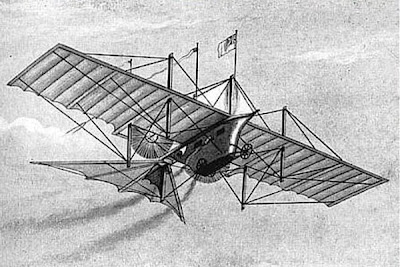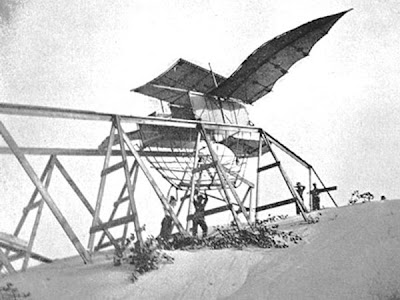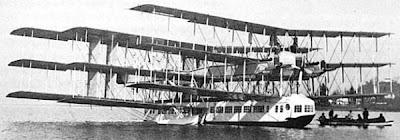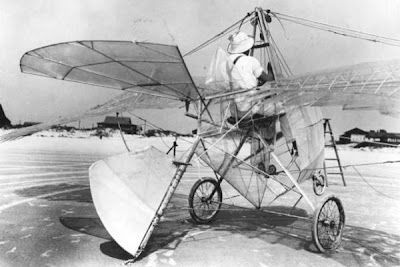skip to main |
skip to sidebar
World's First Airplanes
 History only reminds the winners, those who succeeded and knew fame. The defeated ones fell behind -- but they aren't alone. At this place are also those who arrived on a second place, those who weren't so lucky, those who made wrong choices or those who knew few things about the way to bring fame to themselves. But all those people who aren't registered by the books certainly contributed with their personal efforts, many times a decisive factor, and made the pages of History be turned successfully. That's the History of Aviation, a dangerous and fascinating adventure where Santos Dumont or The Wright Brothers weren't the only people to obtain the credits.
History only reminds the winners, those who succeeded and knew fame. The defeated ones fell behind -- but they aren't alone. At this place are also those who arrived on a second place, those who weren't so lucky, those who made wrong choices or those who knew few things about the way to bring fame to themselves. But all those people who aren't registered by the books certainly contributed with their personal efforts, many times a decisive factor, and made the pages of History be turned successfully. That's the History of Aviation, a dangerous and fascinating adventure where Santos Dumont or The Wright Brothers weren't the only people to obtain the credits. The famous Wright Brothers' fight happened only at the beginning of the 20th century; however, let's go back to a hundred years before the starting point of the modern aviation. The Englishman John Stringfellow, for example, was a truly pioneer. In 1848, he flew through a little distance with an engine heavier than air, conceived and constructed by himself and by another inventor, William Samuel Henson. They named their invention Aerial Steam Carriage, as it was moved by a steam machine. It already had most of the modern airplane characteristics, like propellers, fuselage, undercarriage and control through directional rudder; nevertheless, it had a great difficulty on lifting up to the air. No success.
The famous Wright Brothers' fight happened only at the beginning of the 20th century; however, let's go back to a hundred years before the starting point of the modern aviation. The Englishman John Stringfellow, for example, was a truly pioneer. In 1848, he flew through a little distance with an engine heavier than air, conceived and constructed by himself and by another inventor, William Samuel Henson. They named their invention Aerial Steam Carriage, as it was moved by a steam machine. It already had most of the modern airplane characteristics, like propellers, fuselage, undercarriage and control through directional rudder; nevertheless, it had a great difficulty on lifting up to the air. No success. Some years later, in 1856, Jean-Marie Le Bris chose an energy source more conventional to uplift his engine: instead of horsepower, he chose... a horse. That's right. The animal pulled, by gallop, the "Albatross" -- that was the name of his invention -- as if it was a paper parrot. It was an effort in vain. Le Bris gambled on the wrong horse and had no success. Obviously.
Some years later, in 1856, Jean-Marie Le Bris chose an energy source more conventional to uplift his engine: instead of horsepower, he chose... a horse. That's right. The animal pulled, by gallop, the "Albatross" -- that was the name of his invention -- as if it was a paper parrot. It was an effort in vain. Le Bris gambled on the wrong horse and had no success. Obviously. The idea of imitating birds remained and kept most of the inventors designing gliders. That's what happened with William Paul Butusov, the creator of another "Albatross", which should uplift from a rail. The failure of this trial only showed the inutility of these kinds of engines and reinforced the need for motor machines.
The idea of imitating birds remained and kept most of the inventors designing gliders. That's what happened with William Paul Butusov, the creator of another "Albatross", which should uplift from a rail. The failure of this trial only showed the inutility of these kinds of engines and reinforced the need for motor machines. The American Hiram Maxim was one of those who were convicted of it. He focused on lightness and designed a huge engine inspired on a paper parrot which had two potent steam motors. Mounted on a rail, it flew only 500 meters and that's the end of the experience. However, Maxim showed that it was possible to uplift a heavy engine if an enough powerful motor was available. We were in 1894.
The American Hiram Maxim was one of those who were convicted of it. He focused on lightness and designed a huge engine inspired on a paper parrot which had two potent steam motors. Mounted on a rail, it flew only 500 meters and that's the end of the experience. However, Maxim showed that it was possible to uplift a heavy engine if an enough powerful motor was available. We were in 1894. Horatio Phillips was very important, as he was the first one to practice aerodynamic theories that still make our airplanes fly: the pressure difference between the inferior and the superior surface of a wing. After two more-or-less succeeding trials, he designed an "airplane" with 20 little wings and a propeller, which could uplift from the ground in 1904.
Horatio Phillips was very important, as he was the first one to practice aerodynamic theories that still make our airplanes fly: the pressure difference between the inferior and the superior surface of a wing. After two more-or-less succeeding trials, he designed an "airplane" with 20 little wings and a propeller, which could uplift from the ground in 1904. The multiple-wings-style seemed to be there to stay. In 1921, the Italian Gianni Caproni designed a fantastic seaplane for that time: nine wings and eight motors. The called it Transaero -- it flew once.
The multiple-wings-style seemed to be there to stay. In 1921, the Italian Gianni Caproni designed a fantastic seaplane for that time: nine wings and eight motors. The called it Transaero -- it flew once. But the birds' admirers remained loyal to the gliders, like George White, who, in 1930, invented this bizarre and elegant passarola. We don't know if this engine had ever functioned even once.
But the birds' admirers remained loyal to the gliders, like George White, who, in 1930, invented this bizarre and elegant passarola. We don't know if this engine had ever functioned even once.
 History only reminds the winners, those who succeeded and knew fame. The defeated ones fell behind -- but they aren't alone. At this place are also those who arrived on a second place, those who weren't so lucky, those who made wrong choices or those who knew few things about the way to bring fame to themselves. But all those people who aren't registered by the books certainly contributed with their personal efforts, many times a decisive factor, and made the pages of History be turned successfully. That's the History of Aviation, a dangerous and fascinating adventure where Santos Dumont or The Wright Brothers weren't the only people to obtain the credits.
History only reminds the winners, those who succeeded and knew fame. The defeated ones fell behind -- but they aren't alone. At this place are also those who arrived on a second place, those who weren't so lucky, those who made wrong choices or those who knew few things about the way to bring fame to themselves. But all those people who aren't registered by the books certainly contributed with their personal efforts, many times a decisive factor, and made the pages of History be turned successfully. That's the History of Aviation, a dangerous and fascinating adventure where Santos Dumont or The Wright Brothers weren't the only people to obtain the credits. The famous Wright Brothers' fight happened only at the beginning of the 20th century; however, let's go back to a hundred years before the starting point of the modern aviation. The Englishman John Stringfellow, for example, was a truly pioneer. In 1848, he flew through a little distance with an engine heavier than air, conceived and constructed by himself and by another inventor, William Samuel Henson. They named their invention Aerial Steam Carriage, as it was moved by a steam machine. It already had most of the modern airplane characteristics, like propellers, fuselage, undercarriage and control through directional rudder; nevertheless, it had a great difficulty on lifting up to the air. No success.
The famous Wright Brothers' fight happened only at the beginning of the 20th century; however, let's go back to a hundred years before the starting point of the modern aviation. The Englishman John Stringfellow, for example, was a truly pioneer. In 1848, he flew through a little distance with an engine heavier than air, conceived and constructed by himself and by another inventor, William Samuel Henson. They named their invention Aerial Steam Carriage, as it was moved by a steam machine. It already had most of the modern airplane characteristics, like propellers, fuselage, undercarriage and control through directional rudder; nevertheless, it had a great difficulty on lifting up to the air. No success. Some years later, in 1856, Jean-Marie Le Bris chose an energy source more conventional to uplift his engine: instead of horsepower, he chose... a horse. That's right. The animal pulled, by gallop, the "Albatross" -- that was the name of his invention -- as if it was a paper parrot. It was an effort in vain. Le Bris gambled on the wrong horse and had no success. Obviously.
Some years later, in 1856, Jean-Marie Le Bris chose an energy source more conventional to uplift his engine: instead of horsepower, he chose... a horse. That's right. The animal pulled, by gallop, the "Albatross" -- that was the name of his invention -- as if it was a paper parrot. It was an effort in vain. Le Bris gambled on the wrong horse and had no success. Obviously. The idea of imitating birds remained and kept most of the inventors designing gliders. That's what happened with William Paul Butusov, the creator of another "Albatross", which should uplift from a rail. The failure of this trial only showed the inutility of these kinds of engines and reinforced the need for motor machines.
The idea of imitating birds remained and kept most of the inventors designing gliders. That's what happened with William Paul Butusov, the creator of another "Albatross", which should uplift from a rail. The failure of this trial only showed the inutility of these kinds of engines and reinforced the need for motor machines. The American Hiram Maxim was one of those who were convicted of it. He focused on lightness and designed a huge engine inspired on a paper parrot which had two potent steam motors. Mounted on a rail, it flew only 500 meters and that's the end of the experience. However, Maxim showed that it was possible to uplift a heavy engine if an enough powerful motor was available. We were in 1894.
The American Hiram Maxim was one of those who were convicted of it. He focused on lightness and designed a huge engine inspired on a paper parrot which had two potent steam motors. Mounted on a rail, it flew only 500 meters and that's the end of the experience. However, Maxim showed that it was possible to uplift a heavy engine if an enough powerful motor was available. We were in 1894. Horatio Phillips was very important, as he was the first one to practice aerodynamic theories that still make our airplanes fly: the pressure difference between the inferior and the superior surface of a wing. After two more-or-less succeeding trials, he designed an "airplane" with 20 little wings and a propeller, which could uplift from the ground in 1904.
Horatio Phillips was very important, as he was the first one to practice aerodynamic theories that still make our airplanes fly: the pressure difference between the inferior and the superior surface of a wing. After two more-or-less succeeding trials, he designed an "airplane" with 20 little wings and a propeller, which could uplift from the ground in 1904. The multiple-wings-style seemed to be there to stay. In 1921, the Italian Gianni Caproni designed a fantastic seaplane for that time: nine wings and eight motors. The called it Transaero -- it flew once.
The multiple-wings-style seemed to be there to stay. In 1921, the Italian Gianni Caproni designed a fantastic seaplane for that time: nine wings and eight motors. The called it Transaero -- it flew once. But the birds' admirers remained loyal to the gliders, like George White, who, in 1930, invented this bizarre and elegant passarola. We don't know if this engine had ever functioned even once.
But the birds' admirers remained loyal to the gliders, like George White, who, in 1930, invented this bizarre and elegant passarola. We don't know if this engine had ever functioned even once.







